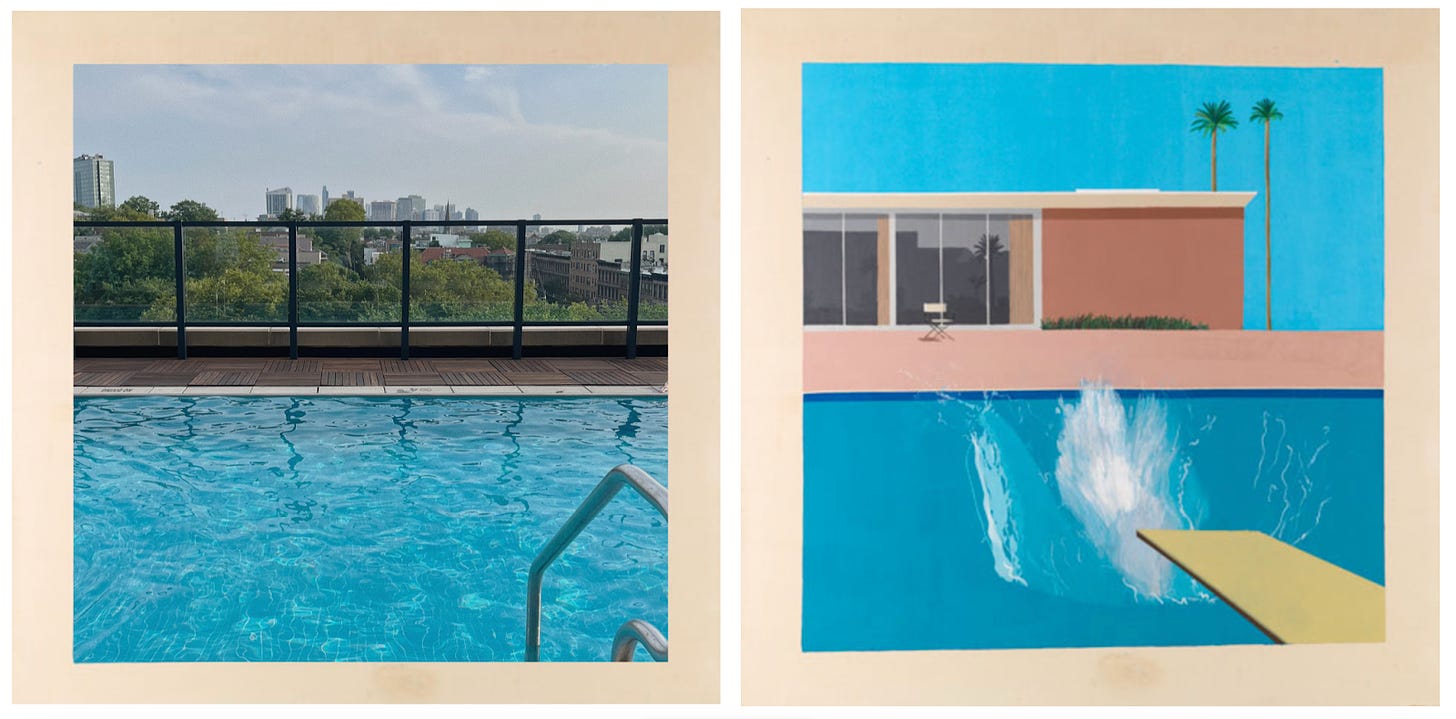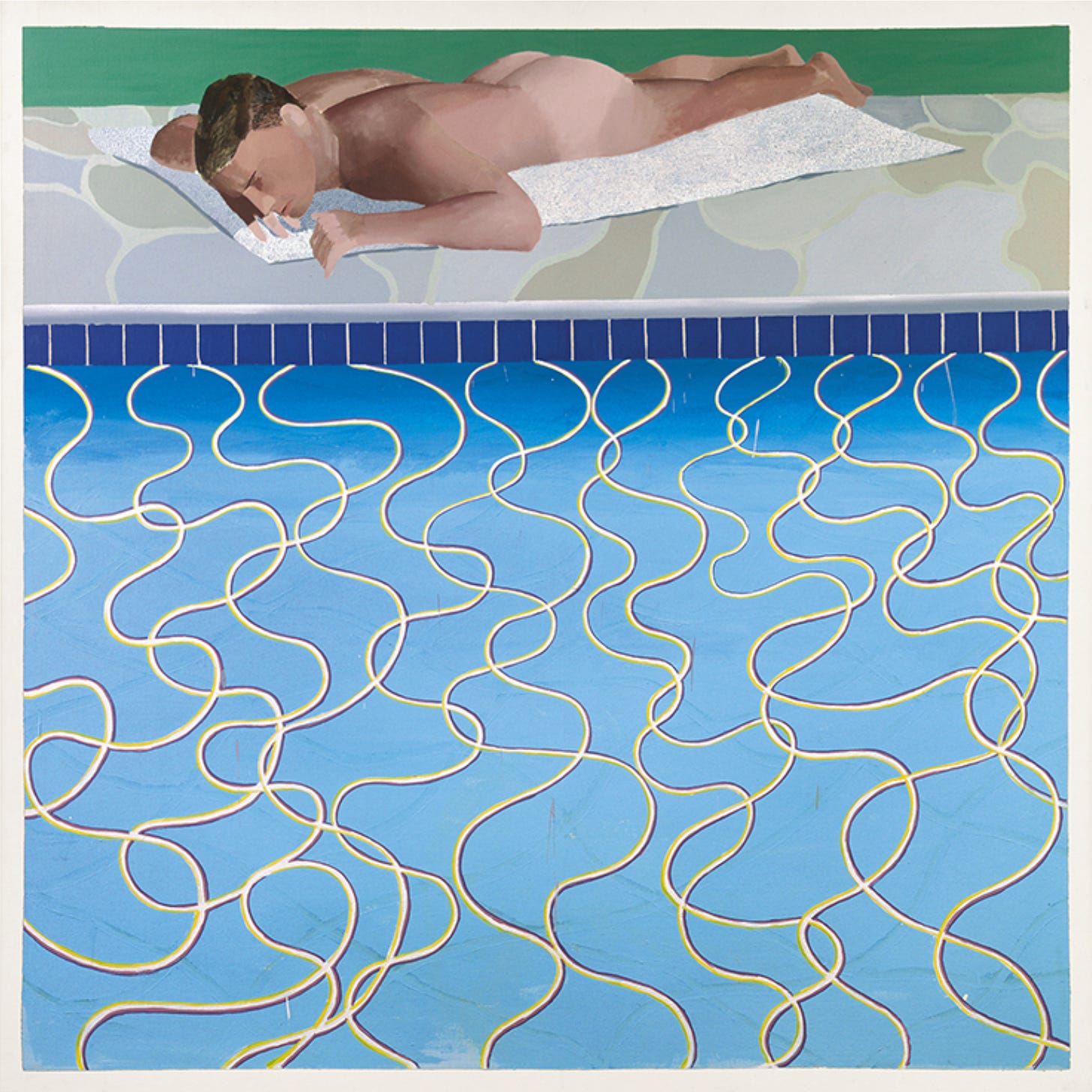
Since moving out of New York, I feel like I’m floating on a cloud every day.
I live right on the Hudson in Hoboken. Being in such vicinity to water is restorative: a light aquatic breeze and sweeping views of Manhattan Island are ever-present. One is simultaneously conscious of the limits of land but also stands at the brink of boundlessness. The pure awe in that.
Awe - this must be the thrill of Georgia O’Keeffe’s first visit to New Mexico, Mary Oliver’s arrival to Provincetown’s blue expanse, and David Hockney’s escape from a dreary homeland to sunny California.
It is this same awe that compelled my feet to wander - and all the space there is here to wander! David Hockney said one of his favorite things about his Hollywood Hills house is that “the roads aren’t straight and you don’t know which one goes down the hill and which one doesn’t”. He also interpreted Carl Sagan’s insistence that we not be satisfied with puny Gods as all about space,
“— how God must be even greater than we dreamed of. Much bigger. The universe, bigger. Grander. Vaster. More spacious.”
Perhaps just like Hockney, who went to LA in the sixties for space and was allergic to New York’s “perspective nightmare” of sharp-edged blocks, I too have always craved space. To traverse in space so my mind can wander too.
Every morning, I go on a long, meandering walk along the water as a second waking. I stroll wherever my feet would take me - past the pier and around the boat house, my ears awake as gentle waves crash against the dainty little beachfront. I may stride through Elysian Park and briskly hike up to Castle Point, to watch red sailboats race down the Hudson against the Manhattan skyline. I may then descend down to the fishing harbor. Perhaps a peek into Sybil’s Cave too.

“I walk in the world to love it.”
Mary Oliver wrote in Long Life. On my walks, I realize how much of my experience of the world is relational: everything is new but familiar, carrying imprints of places I cherish. Castle Point and Marin Headlands grant me the same dramatic perspective. The same bay windows adorn Victorians in the SF Mission District and stately townhouses here on Hudson St. The same sheltered tranquil of my tiny beachfront and Playa Playitas in Manuel Antonio. The rippling glow on the river at sunset, just as splendid as the countless golden hours I’ve witnessed on the Pacific Coast Highway…
Setting matters: Hockney always speaks of feeling freer and painting with brighter colors in California. Here, I find myself softer, gentler, dreamier, more poetic, adamant, and loving. I dress lighter too - often opting for looser fabrics, flowy silks and white poplins that flutter in the breeze. I love who I am here.
There’s a David Hockney quote I particularly adore:
“I don’t think happiness is . . . We just get glimpses, tiny moments, that’s all. But they’re enough.”
These are my tiny glimpses of happiness, all with a whimsical likeness to Hockney's 1960s-70s paintings:
Light: Good Morning to the Window

I’ve always had a soft spot for light. When I toured my apartment, I couldn’t take my eyes off this solarium window in the center of the living room. How it flooded the space with light, with all of Hoboken beyond. I immediately told Alex this should be our home. How grateful we are that it is now.
I like to have my coffee here before my morning walk, basking in light and soft color. I remember how Mary Oliver wrote “every morning, tumult and quietude marry each other and create light.” I also think of Ross Gay’s meditations in The Book of Delights that “iridescence reminds us how all color is a manifestation of, a meditation on, light. Smiling and looking at it, smiling and looking at me looking at it, me smiling and looking at her looking at it, which is simply called sharing what we love, what we find beautiful, which is an ethics.”
Upon discovering Contre-jour in a Hockney catalog, I found its likeness to my solarium window stunning. The perspective carries the Renaissance notion of deeming painting as a window framing the world, and vice versa. Hockney would have seen his painted scene in one of the rooms of the Pavillon de Flore in the Louvre, and exclaimed “oh it’s marvelous! Marvelous! This is a picture in itself…”
I finish my coffee. Tantalized by the sun-drenched sidewalks framed in my window to the world, I head out for my walk.
Still Lifes: Extraordinary Ordinaries

While Hockney’s Still Life on a Glass Table pays homage to the Flemish tradition, it is really an exploration in perspective, optics, and light. Consistent with those in Contre-jour, the color contrasts and sharp edges here accentuate dimensionality. The transparent glass is simultaneously a subject itself and a reflective medium on which other objects make their own image. I happen to own a similar coffee table.
Hockney once shared in an interview with art critic Martin Gayford that “each time I do a still life, I get very excited and realize that there are a thousand things here I can see! Which of them shall I choose? The more I look and think about it, the more I see.” He further laments that the world is very beautiful if you look at it, but “most people don’t look very much with an intensity.”
As I became more familiar with my new surroundings, my daily walks became a vivid exercise in seeing. To see in Mary Oliver’s eyes that
“the world, moist and bountiful, calls to each of us to make a new and serious response.”
What new delights can I discover today? There is always plenty: live jazz in Frank Sinatra park, swing dancing by the water, reading on the pier at dusk, grass’s herbaceous smell, twinkling fireflies. The sensuous silhouette of a wine glass. A new sunflower bloom on my coffee table.
All - surprises, enchants, and confounds - is such an aesthetic thrill.
The Pool: Timelessness and Flow
“I used to tell my friends that the inventor of painting, according to the poets, was Narcissus… What is painting but the act of embracing by means of art the surface of the pool?” —Leon Battista Alberti, De Pictura (On Painting), 1435
Hockney was famously drawn to the Californian lifestyle, where light is strong and nearly everyone had a swimming pool. Between 1964 and 1971, Hockney painted numerous Californian pools. A Bigger Splash is my favorite of the series. I love its clean, modernist contours, the juxtaposition of the diagonal yellow diving board and turquoise waters giving perspective. The play of surface and depth in two-dimensionality. The gleaming evocation of pleasure.
“When you photograph a splash, you’re freezing a moment and it becomes something else. I realize that a splash could never be seen this way in real life, it happens too quickly. And I was amused by this, so I painted it in a very, very slow way.” Hockney recalled his process. He apparently spent 7 days going over the splash with small brushes in delicate strokes. A delightful paradox of freezing a snap moment in timelessness.
I am lucky enough to have a rooftop pool in my building. I visit it frequently. These are the dog days of dreams: floating across the pool on my back, as in Mary Oliver’s “we stroll on its surface freely, citizens of the water world”. The turquoise water flows above my ears - I revel in comforting silence. My mind is serene, still. Time is frozen, distorted. Timeless. Self-consciousness disappears. This is flow.
I would have ended this piece above and published it two weeks ago.
The day before I planned to publish, Alex was severely injured in a road accident and rushed to the ER for emergency surgery. Grueling days of hospital stays, more surgeries, and home care followed. It didn’t feel right to publish this piece at the time, and I considered filing it away forever.
I eventually decided against it. I realized why I keep returning to Hockney—beyond his chronicling of light and life in California, his cerebral approach to image-making—is his defiant, relentless, and inextinguishable love for life. That “in the face of his encroaching deafness, of the way AIDS and cancer have been laying waste the community of his closest friends, of the death of his ninety-eight-year-old mother, that unshakable treasuring of life itself has always been the leitmotif of Hockney’s [work],” wrote New Yorker staff writer Lawrence Weschler back in Nov 2001’s Artkrush. How even in the deepest pain - there are glimpses of joy.
I needed Hockney’s reminder.
More recently, in his pandemic dialogue with art critic Martin Gayford documented in Spring Cannot be Canceled, Hockney asks “what is stress? It’s worrying about something in the future. Art is now.”
All of my days are now: bounteous days to make my new and serious response. Embracing and embraced by light, walks by the water, maintaining a home full of still life-esque delight for Alex’s recovery, work in full focus. A float in the pool melts away all stresses at the end of every difficult day.
“Keep painting those pictures… I really believe the source of art is love. Life is a celebration. I love life.” —David Hockney










